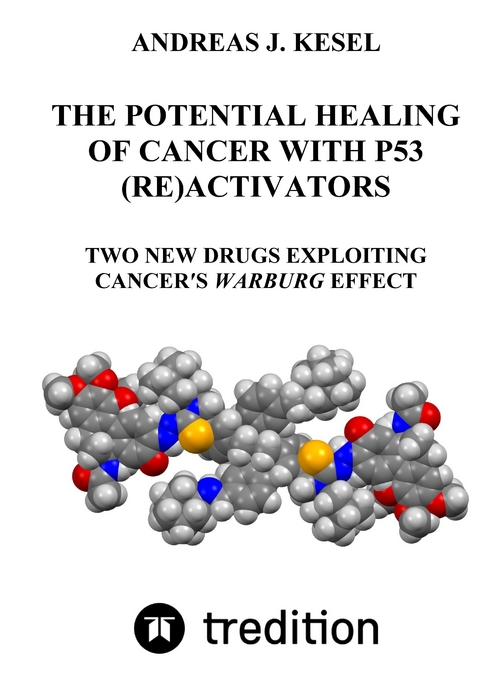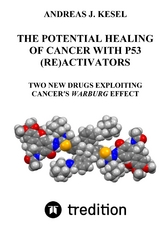The purpose of this book is to propose a new strategy to heal human cancer completely with two entirely new drug compounds exploiting cancer's Warburg effect characterized by a defective mitochondrial aerobic respiration, substituted for by cytosolic aerobic fermentation/glycolysis of glucose into L-(+)-lactic acid. The two essentially new drugs P(op)T(est)162 and PT167 were discovered and developed by Andreas J. Kesel and internationally patented by PopTest Oncology LLC/Palisades Therapeutics. The in vitro antineoplastic highly efficacious drug PT167 represents a covalent combination of PT162 and PT166. The intermediate drug PT166 is an entirely new colchic(in)oid derivative synthesized from colchicine. PT166's structure was determined by X-ray crystallography. PT162 and PT167 were active in vitro versus 60 cancer cell lines of the National Cancer Institute (NCI) Developmental Therapeutics Program (DTP) 60-cancer cell testing. PT162 and PT167 both not only stop the growth of cancer cells to ±0% (cancerostatic effect), but completely kill all 60 cancer cells to a level of -100% (tumoricidal effect). PT162 and PT167 induce mitochondrial apoptosis (under cytochrome c release) in all cancer cells tested by (re)activating (in most cancers impaired) p53 function which results in a decrease of cancer's dysregulated cyclin D1 and an induction of the cell cycle-halting cyclin-dependent kinase inhibitor p21Waf1/p21Cip1.It was found that compound 1 (PT162, NSC 796018), a new compound never synthesized before [according to Chemical Abstracts Service (CAS®) SciFinder® search], induced apoptosis in all cell lines of the National Cancer Institute (NCI) Developmental Therapeutics Program (DTP) 60-cancer cell 5-dose testing, excluding leukemia cell lines, in the micromolar range of growth inhibition 50% (GI50). The author decided to merge compound 1 (PT162, NSC 796018) with the colchic(in)oid compound 2 (PT166, NSC 750423) which showed submicromolar GI50 in the NCI DTP 60-cancer cell 5-dose testing, but did not induce cancer cell apoptosis. Compound 2 (PT166, NSC 750423) was synthesized from colchicine and thiosemicarbazide in an one-step procedure and represents a new compound never synthesized before [according to Chemical Abstracts Service (CAS®) SciFinder® search] just as compound 1 (PT162, NSC 796018). Compound 1 (PT162, NSC 796018) reacted with compound 2 (PT166, NSC 750423) under impact of sodium hydroxide (NaOH) to give compound 3. Compound 3 (PT167, NSC 799315), a new compound never synthesized before [according to Chemical Abstracts Service (CAS®) SciFinder® search], showed submicromolar GI50 in the NCI DTP 60-cancer cell 5-dose testing constantly in most cell lines including leukemia cells. Importantly, compound 3 (PT167, NSC 799315) was able to induce apoptosis in all investigated cancer cells, including leukemia cell lines, with a Mean of Inhibition Data (MID) for total growth inhibition (TGI, growth inhibition 100%) of 4.57 µM, and a MID for lethal concentration 50% (LC50) of 15.85 µM. The author reports here the chemistry and NCI DTP 60-cancer cell 5-dose testing data for compound 1 (PT162, NSC 796018), compound 2 (PT166, NSC 750423) and compound 3 (PT167, NSC 799315), and demonstrates the apoptotic release of cytochrome c into the cytosol and activation of effector caspases induced by compounds 1 and 3. The author proposes that compound 1 and compound 3 induce apoptosis according to the Warburg hypothesis of pre-damaged respiration as a hallmark of cancer by exploiting the defect in mitochondrial cardiolipin-cytochrome c association in cancer cells.
1990 ABITUR. 1991–1993 CHEMISTRY SCHOOL DR. ERWIN ELHARDT, STUDY OF CHEMICAL-TECHNICAL ASSISTANT (CTA). 1993 PRACTICAL TRAINING, MAX-PLANCK-INSTITUTE FOR BIOCHEMISTRY, MARTINSRIED, GERMANY, DEPARTMENT OF PROTEIN CHEMISTRY OF DR. FRIEDRICH LOTTSPEICH, IN THE FORMER LABORATORY OF DR. PEHR VICTOR EDMAN (ADVISOR: KERSTIN ANDERSSON, GENERAL TRAINING IN PROTEIN CHEMISTRY, ELECTROPHORESIS, AND PROTEIN SEQUENCING BY THE EDMAN METHOD). 1993 PRACTICAL TRAINING, MAX-PLANCK-INSTITUTE FOR NEUROBIOLOGY, MARTINSRIED, GERMANY, DEPARTMENT OF NEUROIMMUNOLOGY OF PROF. DR. DR. H.C. HARTMUT WEKERLE (ADVISOR: DR. ANTONIO IGLESIAS, TRAINING IN MOLECULAR BIOLOGY AND DNA SEQUENCING). 1993–1995 WORK AS CHEMICAL-TECHNICAL ASSISTANT AT MAX-PLANCK-INSTITUTE FOR BIOCHEMISTRY IN THE DEPARTMENT OF VIRUS RESEARCH OF PROF. DR. DR. DR. H.C. PETER HANS HOFSCHNEIDER, WITH SPECIAL TRAINING IN THE MOLECULAR BIOLOGY OF HUMAN HEPATITIS B VIRUS. 1995–2000 STUDY OF PHARMACY AT LUDWIG-MAXIMILIANS-UNIVERSITY, MUNICH, GERMANY. 2004–2005 STUDY OF PHARMACY AT JULIUS-MAXIMILIANS UNIVERSITY OF WÜRZBURG, GERMANY. 2006–2011 DOCTORAL STUDY AT JULIUS-MAXIMILIANS UNIVERSITY OF WÜRZBURG, GERMANY, IN THE DEPARTMENT OF PHARMACEUTICAL CHEMISTRY OF PROF. DR. ULRIKE HOLZGRABE. 2011–2015 PUBLICATION WORK AS PRIVATE RESEARCHER IN MUNICH, GERMANY. 2015–2017 WORK AS CHIEF MEDICINAL CHEMIST FOR POP TEST ONCOLOGY LLC OF RANDICE LISA ALTSCHUL, CLIFFSIDE PARK, NJ, USA. 1998 ELECTION AS AN EXTERNAL MEMBER OF THE NEW YORK ACADEMY OF SCIENCES, NEW YORK, USA. 2005 MEMBER OF THE AMERICAN CHEMICAL SOCIETY, DIVISION OF MEDICINAL CHEMISTRY. 18 PUBLICATIONS AND/OR CONGRESS ABSTRACTS IN PEER-REVIEWED JOURNALS. 2 BOOKS PUBLISHED. 31 CO-AUTHORED PATENTS.
| Erscheinungsdatum |
21.08.2023
|
| Verlagsort |
München |
| Sprache |
englisch |
| Maße |
148 x 210 mm |
| Gewicht |
614 g |
| Themenwelt
|
Medizin / Pharmazie ► Medizinische Fachgebiete ► Pharmakologie / Pharmakotherapie |
| Schlagworte |
cancer growth • cancer's Warburg effect • cytochrome c release • Mitochondrial apoptosis • p53 • p53 (re)activators • tumoricidal drug effect • Tumor metastasis |
| ISBN-10 |
3-384-00312-8 / 3384003128 |
| ISBN-13 |
978-3-384-00312-6 / 9783384003126 |
| Zustand |
Neuware |




